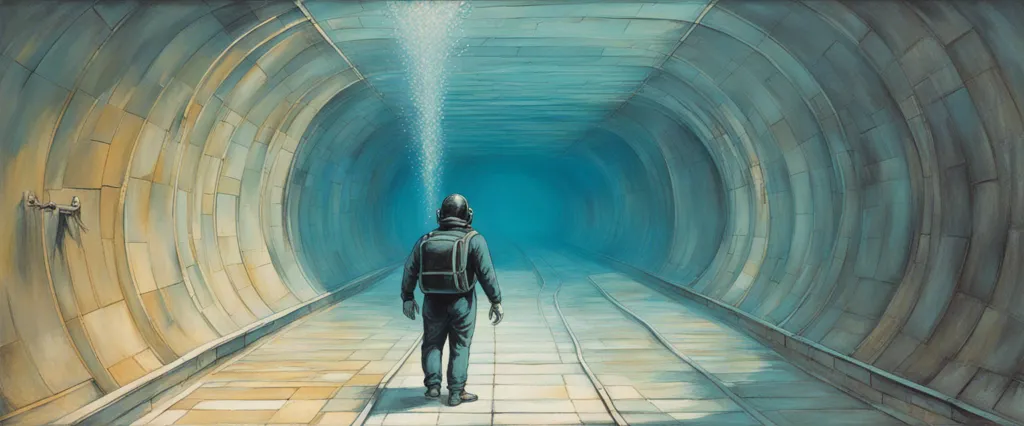
In “The Path of Least Resistance,” acclaimed author Robert Fritz explores the intricate relationship between creativity, innovation, and human potential. This insightful and enlightening book delves into the concept of structural tension, emphasizing the transformative power of aligning our efforts with our desired outcomes. Fritz, a renowned composer, filmmaker, and organizational consultant, has dedicated his life to unraveling the secrets of human achievement. Through his multidisciplinary approach, he has empowered countless individuals and organizations to break free from the constraints of conventional thinking and embrace their innate creative abilities. By presenting practical frameworks and thought-provoking insights, Fritz encourages readers to embrace change, overcome obstacles, and forge their own path towards a more fulfilling and successful life.
Chapter 1: Understanding the Creative Process
Chapter 1 of “The Path of Least Resistance” by Robert Fritz is titled “Understanding the Creative Process.” This chapter sets the foundation for the book by explaining the concept of creative thinking and the different elements that contribute to the creative process.
Fritz emphasizes that creativity is not confined to artists or inventors; it is a natural human ability that can be applied to all aspects of life. He introduces the idea of structural tension, which is the gap between the current reality and the desired outcome. This tension creates the motivation to move towards a desired result, sparking the creative process.
The author explains that creativity emerges when one is able to envision a desired outcome clearly, and then takes steps to make that vision a reality. Fritz highlights the importance of overcoming conventional thinking patterns that limit creative possibilities. Instead, he encourages individuals to adopt a structural way of thinking, which involves focusing on the desired result rather than being weighed down by current limitations.
Furthermore, the chapter introduces the concept of creative tension, which is the driving force behind the creative process. Fritz suggests that creative tension is resolved by aligning actions with the desired outcome, which ultimately leads to the transformation of reality. He highlights the significance of letting go of preconceived notions and embracing a mindset that welcomes new possibilities.
In summary, Chapter 1 serves as an introduction to the creative process and sets the stage for the concepts explored throughout the book. Fritz emphasizes the importance of shifting one’s thinking to focus on desired outcomes, embracing creative tension, and breaking free from conventional limitations to foster innovation and creativity in all aspects of life.
Chapter 2: Recognizing Structural Tension
Chapter 2 of “The Path of Least Resistance” by Robert Fritz focuses on the concept of recognizing structural tension. Structural tension refers to the gap between one’s current reality and the ideal desired outcome or vision. Fritz argues that this tension is an essential force that drives creative expressions and growth.
The chapter begins by highlighting how most people are driven by external influences such as societal expectations or personal desires. Fritz believes that this external focus leads to a reactive approach, where individuals try to fix or alleviate problems rather than proactively create what they truly desire. He argues that to break free from this cycle, one must focus on the inherent structural tension within their lives.
Fritz explains that in order to recognize structural tension, one must first establish a clear vision of what they desire. This vision should be independent of any external influences and should resonate deeply with one’s own values and aspirations. Then, individuals must assess the current reality and identify the gap between the vision and their present circumstances.
By recognizing this tension, individuals can start reshaping their actions and decisions to bridge the gap and align with their vision. Fritz emphasizes that this requires a shift from reactive problem-solving to proactive creation. It involves embracing the tension and allowing it to guide one’s choices, actions, and decision-making processes.
The chapter also explores the concept of polarities, which refers to complementary forces that exist within any situation. Fritz suggests that recognizing and managing polarities is crucial in addressing structural tension effectively. Rather than perceiving polarities as opposing forces, individuals should learn to harmonize them and use them as sources of creative energy and inspiration.
Overall, Chapter 2 of “The Path of Least Resistance” emphasizes the importance of recognizing and embracing structural tension as a catalyst for personal growth, creativity, and the realization of one’s vision. By shifting from a reactive mindset to a proactive approach, individuals can navigate the tension and channel it towards meaningful and purposeful action.
Chapter 3: Shifting from Reactive to Creative Mode
Chapter 3 of “The Path of Least Resistance” by Robert Fritz is titled “Shifting from Reactive to Creative Mode.” This chapter explores the concept of shifting our mindset from reactive to creative mode in order to accomplish our goals and live more fulfilling lives.
Fritz begins by highlighting the reactive mindset that most people adopt. In this mode, individuals typically respond to external circumstances and allow them to dictate their actions. They often feel overwhelmed and trapped by the demands of the world, leading to a sense of being stuck or limited in their choices. This reactive mode of thinking is passive and leaves little room for intentional decision-making and personal growth.
Fritz then introduces the idea of shifting to a creative mindset. He emphasizes the importance of taking responsibility for one’s life and actively shaping it according to one’s desires and values. This involves identifying personal goals and working towards them with purpose and determination. By shifting to a creative mode, individuals can break free from the limitations of the reactive mindset and take control of their own destiny.
The author also emphasizes the significance of having a clear vision of the desired outcome. He suggests that by visualizing the end result, individuals can navigate through obstacles and make choices that align with their goals. This is in contrast to the reactive mode, where people tend to focus on immediate problems without considering their long-term aspirations.
Furthermore, Fritz highlights the role of tension in the creative process. He explains that tension arises when there is a discrepancy between the current reality and the envisioned future. Rather than avoiding tension or seeing it as a negative force, Fritz encourages individuals to embrace it as a catalyst for change and growth. By harnessing this tension, individuals can take deliberate actions and make decisions that align with their vision.
In conclusion, Chapter 3 of “The Path of Least Resistance” explores the shift from a reactive to a creative mindset. It emphasizes the importance of taking responsibility for one’s life, having a clear vision of the desired outcome, and embracing tension as a catalyst for personal growth and achievement. By adopting a creative mindset, individuals can break free from limitations and actively shape their lives according to their aspirations.
Chapter 4: Creating Structural Tension

Chapter 4: Creating Structural Tension of the book “The Path of Least Resistance” by Robert Fritz explores the concept of structural tension and its importance in creating desired outcomes. The chapter highlights the idea that many people have a tendency to focus on solving problems rather than creating what they truly want.
Fritz explains that structural tension is the gap between where you are currently and where you want to be. By focusing on this gap, individuals can channel their energy and efforts towards achieving their desired outcomes. He argues that successful individuals are not necessarily problem solvers, but rather creators of outcomes.
The chapter emphasizes the significance of understanding and defining one’s vision. Fritz believes that clear, well-defined visions are essential for creating structural tension. He suggests that individuals should set specific goals and outcomes they want to achieve, ensuring that these goals are aligned with their personal values and aspirations.
According to Fritz, creating structural tension involves constantly assessing the current reality and comparing it to the desired outcome. This evaluation helps identify the gaps that need to be bridged and allows for a clearer understanding of the steps required to reach the desired outcome. He encourages individuals to refine and adjust their visions when necessary, remaining flexible and adaptable throughout the process.
Fritz also emphasizes the importance of visualization in creating structural tension. By vividly imagining the desired outcome, individuals can form a deeper emotional connection to their goals and increase their motivation to achieve them.
In conclusion, Chapter 4 of “The Path of Least Resistance” highlights the significance of creating structural tension in order to achieve desired outcomes. The chapter focuses on the importance of defining clear visions, continuously assessing the gaps between the current reality and desired outcome, and employing visualization techniques to enhance motivation and focus. By adopting these strategies, individuals can shift their focus from problem-solving to outcome creation, increasing their chances of success.
Chapter 5: Overcoming Resistance
Chapter 5: Overcoming Resistance of “The Path of Least Resistance” by Robert Fritz explores the concept of resistance and provides strategies for overcoming it. The author argues that resistance is a natural and common occurrence that hinders progress and prevents individuals from creating and achieving their desired outcomes.
Fritz begins by emphasizing that resistance can manifest in various forms, such as procrastination, fear, self-doubt, and excuses. He explains that resistance arises due to the conflict between current reality and the vision of what an individual wants to create. This conflict creates tension, which is often resolved by giving in to resistance and maintaining the familiar and comfortable. However, this “path of least resistance” leads to stagnation and prevents personal growth.
To overcome resistance, Fritz introduces the concept of the creative process. He suggests that individuals need to have a clear understanding of their vision or desired outcome. By focusing on this vision, one can gain clarity and drive, making it easier to overcome resistance. Additionally, Fritz stresses the importance of taking consistent action towards the desired outcome, even if progress seems slow or challenging.
Furthermore, the author highlights the significance of perseverance in overcoming resistance. He explains that setbacks and obstacles are inevitable, but maintaining determination and resilience is essential. Fritz emphasizes that individuals need to embrace mistakes and failures as learning opportunities rather than reasons to give up.
In conclusion, Chapter 5 of “The Path of Least Resistance” provides valuable insights and strategies for overcoming resistance. By understanding and acknowledging the presence of resistance, individuals can redirect their focus towards their vision, take consistent action, and persevere in the face of challenges. Through these practices, they can overcome resistance and create the outcomes they desire.
Chapter 6: Aligning Vision and Reality
Chapter 6: Aligning Vision and Reality of the book “The Path of Least Resistance” by Robert Fritz emphasizes the importance of aligning one’s vision with reality in order to achieve desired outcomes effectively.
Fritz begins by highlighting the common misconception that vision and reality are inherently in conflict with each other. He asserts that the interplay between vision and reality is not about compromise or sacrifice but about creative tension. Fritz suggests that tension between the existing reality and the desired vision can be utilized as a driving force to propel individuals towards their goals.
The author introduces the concept of structural tension, which involves comparing the current reality with the desired outcome. By recognizing the gaps between the two, individuals can identify the necessary steps to close the gap and align their current actions with their vision. Fritz emphasizes that this process is crucial for personal growth and creation.
He emphasizes that it is counterproductive to be solely focused on the end result without acknowledging and understanding the initial conditions that need to be improved. Fritz suggests that aligning vision with reality requires focusing on the specific actions needed to bridge the gap, rather than fixating on the end goal.
Furthermore, he explains that the alignment process involves understanding the underlying structures that contribute to one’s current reality. These structures encompass not only external factors but also internal mental frameworks, beliefs, and assumptions. To align vision and reality effectively, Fritz advises questioning and challenging these structures to reveal new possibilities and overcome limiting factors.
The chapter concludes with the author highlighting the significance of aligning one’s vision and reality in maintaining long-term motivation and commitment. Fritz encourages readers to actively engage in aligning their actions with their desired outcomes, continually adjusting and readjusting along the way, and embracing the creative tension between vision and reality as a catalyst for progress and growth.
Chapter 7: Harnessing the Power of Structural Tension
Chapter 7 of “The Path of Least Resistance” by Robert Fritz is titled “Harnessing the Power of Structural Tension.” In this chapter, Fritz explores the concept of structural tension and how it can be harnessed to achieve desired outcomes.
Structural tension is the natural gap between the current reality and the desired outcome or vision. Fritz argues that this tension is not something to be avoided or eliminated, but rather a force that can be utilized to move toward one’s goals. He explains that by embracing this tension, one can create a powerful driving force that propels them forward.
To effectively harness structural tension, Fritz suggests a systematic approach that involves five steps. The first step is to clearly define the desired outcome or vision. It is essential to have a specific and compelling goal in mind.
The second step is to assess and fully understand the current reality. One must objectively evaluate their present circumstances and identify the obstacles or limitations that stand in the way of their desired outcome.
The third step is to identify the structural tension between the current reality and the desired outcome. This tension should be seen as an opportunity rather than a hindrance.
Next, Fritz emphasizes the importance of taking concrete actions to bridge the gap. This involves developing a plan and executing it step by step while continuously adjusting and adapting as necessary.
Finally, Fritz highlights the significance of maintaining an ongoing awareness of the structural tension. By regularly revisiting the tension and keeping it in focus, one can stay motivated and committed to achieving their desired outcome.
Overall, the chapter emphasizes the transformative power of structural tension in driving individuals towards their goals. By embracing this tension and following the provided steps, individuals can effectively harness its energy to create positive change and achieve their desired outcomes.

Chapter 8: Sustaining Momentum and Continuous Improvement
Chapter 8 of “The Path of Least Resistance” by Robert Fritz focuses on sustaining momentum and continuous improvement. Fritz starts by pointing out that most efforts and initiatives tend to lose steam over time because people fail to maintain the conditions that originally led to success. He argues that in order to sustain momentum, it is crucial to create systems that support continuous improvement rather than relying solely on individual motivation or willpower.
One of the key concepts introduced in this chapter is the idea of structural tension. Fritz explains that by clarifying our desired outcomes and understanding the current reality, we can identify the gap between them and create a tension that drives us forward. This structural tension allows us to stay focused and motivated to achieve our goals in the long run, even when faced with inevitable challenges or setbacks.
To sustain momentum, Fritz emphasizes the importance of feedback loops. He suggests implementing various feedback systems that continuously provide information on progress, quality, and effectiveness. These feedback loops help identify weak points and areas for improvement, enabling individuals and organizations to make necessary adjustments and maintain forward momentum.
Furthermore, Fritz encourages reevaluating and adjusting systems regularly. He argues that systems should be flexible and adaptable, as the external environment is constantly changing. By actively seeking feedback, making improvements, and continually innovating, individuals and organizations can adapt to new circumstances and sustain their momentum.
Overall, Chapter 8 of “The Path of Least Resistance” highlights the significance of creating supportive systems, leveraging structural tension, implementing feedback loops, and embracing continuous improvement. By maintaining these practices, individuals and organizations can sustain their progress, achieve long-term success, and overcome obstacles along their journey.
After Reading
In “The Path of Least Resistance,” Robert Fritz presents a groundbreaking approach to understanding and achieving success in any endeavor. Through his concept of structural tension, Fritz emphasizes the importance of clarifying one’s vision and identifying the underlying obstacles that prevent its realization. By focusing on the fundamental principles of creativity and examining the interconnectedness of our beliefs, thoughts, and actions, Fritz provides practical tools and techniques for transforming limitations into opportunities for growth. Ultimately, he encourages readers to embrace proactive change, break free from old patterns, and embark on a path towards authentic fulfillment and self-expression.
1. The Alchemist” by Paulo Coelho – This mesmerizing novel takes readers on a spiritual journey as Santiago, a young shepherd, seeks his personal legend. Full of wisdom, inspiration, and enchantment, Coelho’s masterpiece teaches us the importance of following our dreams and the power of listening to our hearts.
2. “To Kill a Mockingbird” by Harper Lee – A timeless classic, this novel explores themes of racism, justice, and moral growth through the eyes of Scout Finch. Lee’s poignant storytelling and compelling characters make it a must-read, reminding us of the importance of empathy and compassion.
3. Sapiens: A Brief History of Humankind” by Yuval Noah Harari – In this thought-provoking non-fiction book, Harari traces the history of Homo sapiens, examining how our species developed and conquered the world. Blending anthropology, biology, and history, Harari presents a fascinating narrative that challenges our understanding of human nature and our place in the world.
4. The Power of Now” by Eckhart Tolle – This groundbreaking spiritual guide offers a fresh perspective on finding inner peace and living in the present moment. Tolle eloquently explains the concept of mindfulness and provides practical advice for letting go of past regrets and future anxieties, leading to a more fulfilling and enlightened life.
5. The Great Gatsby” by F. Scott Fitzgerald – Set in the Roaring Twenties, Fitzgerald’s novel explores the disillusionment and decadence of the American Dream through the eyes of Jay Gatsby. With its lyrical prose and vivid portrayal of the Jazz Age, this literary masterpiece captures the allure and tragedy of a bygone era, making it a worthwhile read for all literature enthusiasts.



